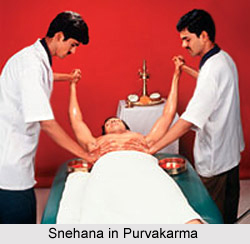 Snehana is the very step of Purvakarma, which means oleation in simple terms. It saturates the body with medicated oils and herbals. In Ayurveda, there are basically two forms of saturation mainly bahya snehana that means external oleation. In this form medicated oils are used extensively and they are vigorously massaged into the body. The second form is the abhyantar snehana that means internal oleation. In this form, medicated oils are ingested. Generally, four types of oleaginous substances are used and they are vegetable oils (taila), animal fats (vasa), fat from bone marrow (majja) and clarified butter (ghee). The oils are used that match the needs of the patients. Snehana employs those substances that have the properties of fluidity and oiliness. Such substances can penetrate even the finest tissues of the body and promote secretions. Each and every property has a specific effect and in combination they fulfill five important purposes and they are -
Snehana is the very step of Purvakarma, which means oleation in simple terms. It saturates the body with medicated oils and herbals. In Ayurveda, there are basically two forms of saturation mainly bahya snehana that means external oleation. In this form medicated oils are used extensively and they are vigorously massaged into the body. The second form is the abhyantar snehana that means internal oleation. In this form, medicated oils are ingested. Generally, four types of oleaginous substances are used and they are vegetable oils (taila), animal fats (vasa), fat from bone marrow (majja) and clarified butter (ghee). The oils are used that match the needs of the patients. Snehana employs those substances that have the properties of fluidity and oiliness. Such substances can penetrate even the finest tissues of the body and promote secretions. Each and every property has a specific effect and in combination they fulfill five important purposes and they are -
* They enhance the secretions through which the doshas transport malas and aama to the gastrointestinal tract for removal from the body.
* They also induce the dhatus in order to give up their accumulated toxins. .
* They soothe as well as nourish vata by its unctuous qualities.
* They lubricate and protect the dhatus from damaging while aama is being removed.
* In addition, they remove the obstructions in the shrotas or the channels.
Snehana or oleation also helps in preventing physiological tear and wear. All the body`s moving parts experience friction and lubrication protects these parts from burning out or from jamming. Oil lubricates and protects the tissues from loosened aama while it is being discharged. Repeated applications of oil to the various mucous membranes enhance secretions. Oleation stimulates secretions in the dhatus that start to liquefy the glutinous aama deposited there. Oil helps in dissolving aama`s sticky grip on the dhatus and it also enhances and revives each dhatu`s metabolism and reopening its channels. The secretions also have the effect of binding the malas together so that they can be transported out of the body.
One of the main ingredients used in snehana is sesame oil (til). It is mainly used in external application or bahya snehana. It has a warming effect and it easily penetrates and nourishes the skin. It soothes and reduces the effects of excess vata without aggravating kapha and it also promotes strength and stability. Sesame and other oils used in snehana are prepared with herbal decorations to enhance their effectiveness for individual patients. Another main ingredient is herbalized ghee. It is considered as the main substance used in internal oleation. It is made by processing butter and it contains the least saturated fat or any type of fatty substance. In proportionate amount, it actually increases the strength of the digestive agnis by decreasing the heat and inflammation because of excess pitta. It is very beneficial for internal lubrication. Herbalized ghee also carries the therapeutic qualities of the other herbal substances without losing its own capacity to increase the digestive fire and enhancing secretions. Animal fat and bone marrow fat are also used for the internal application or abhyantar snehana. These oils are a bit heavy and they are hard to digest. They possess the capability of producing excess kapha and aama in case the digestive agni is weak. That is how they are used only for specific disorders such as leukaemia, cancer and other degenerative diseases.
Snehana in Purva karma is essential for disposal of all the waste products of the body and in restoring normal vata function. Oleation also reduces the coldness and dryness associated with vata. Almost 53 herbs are used in the entire process of oleation. These herbs not only help the oil to dislodge toxic waste products but they also encourage the dhatus to expel the oil. Some of the herbs that are commonly used in snehana are kutki (Picrorhiza Kurroa), guduchi (Tinospora Cardifolia), chitrak (Plumbago Zeylanica), ginger root, haritaki (Terminalia Chebula) and many more. These herbs also help in preventing cholesterol from being deposited in the body.
Snehana in Purvakarma holds special significance as they have some specific effects. In Ayurveda, Snehana is considered as an adjunctive and preparatory therapy. Snehana implies tenderness, love and kindness.





